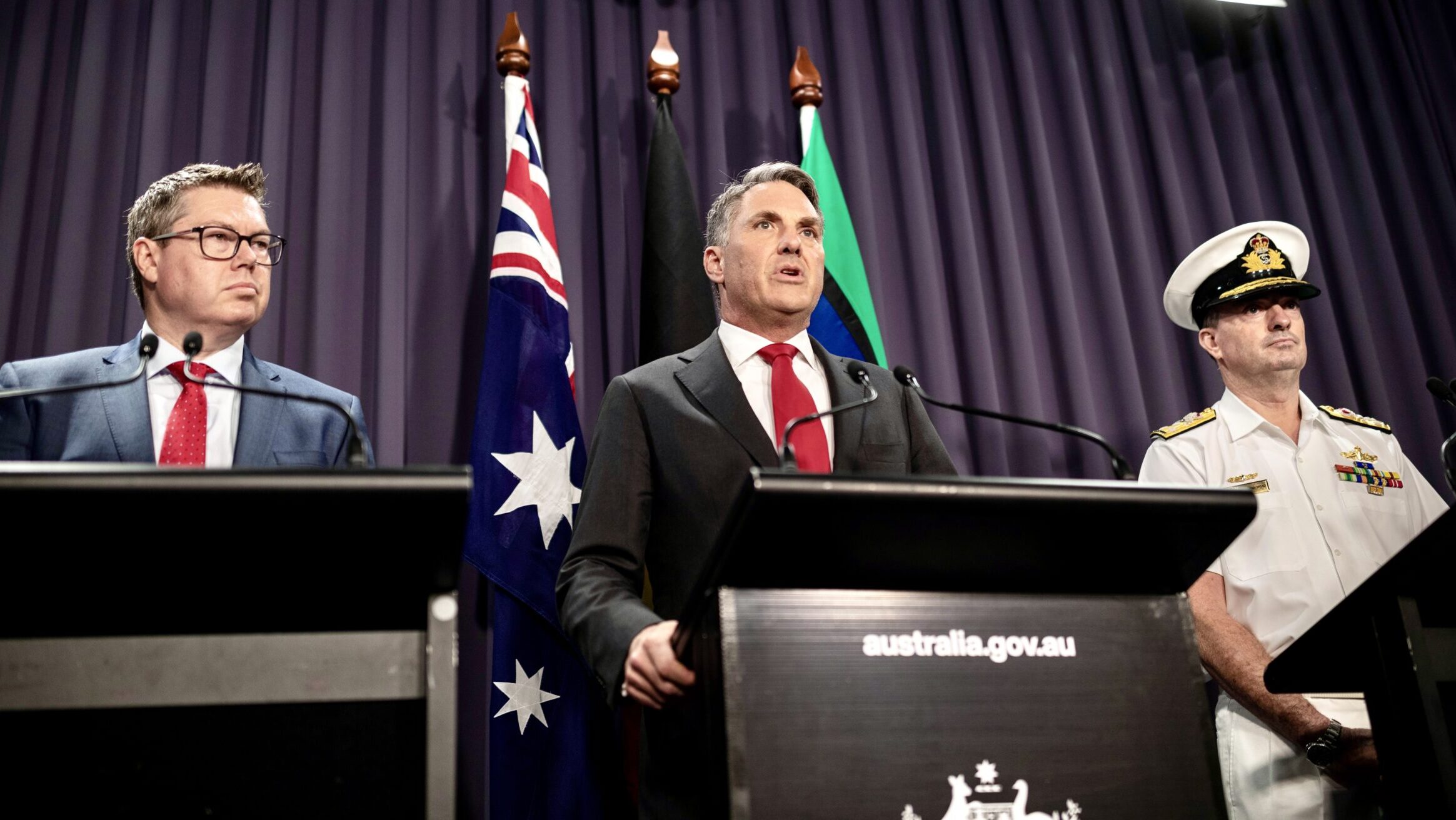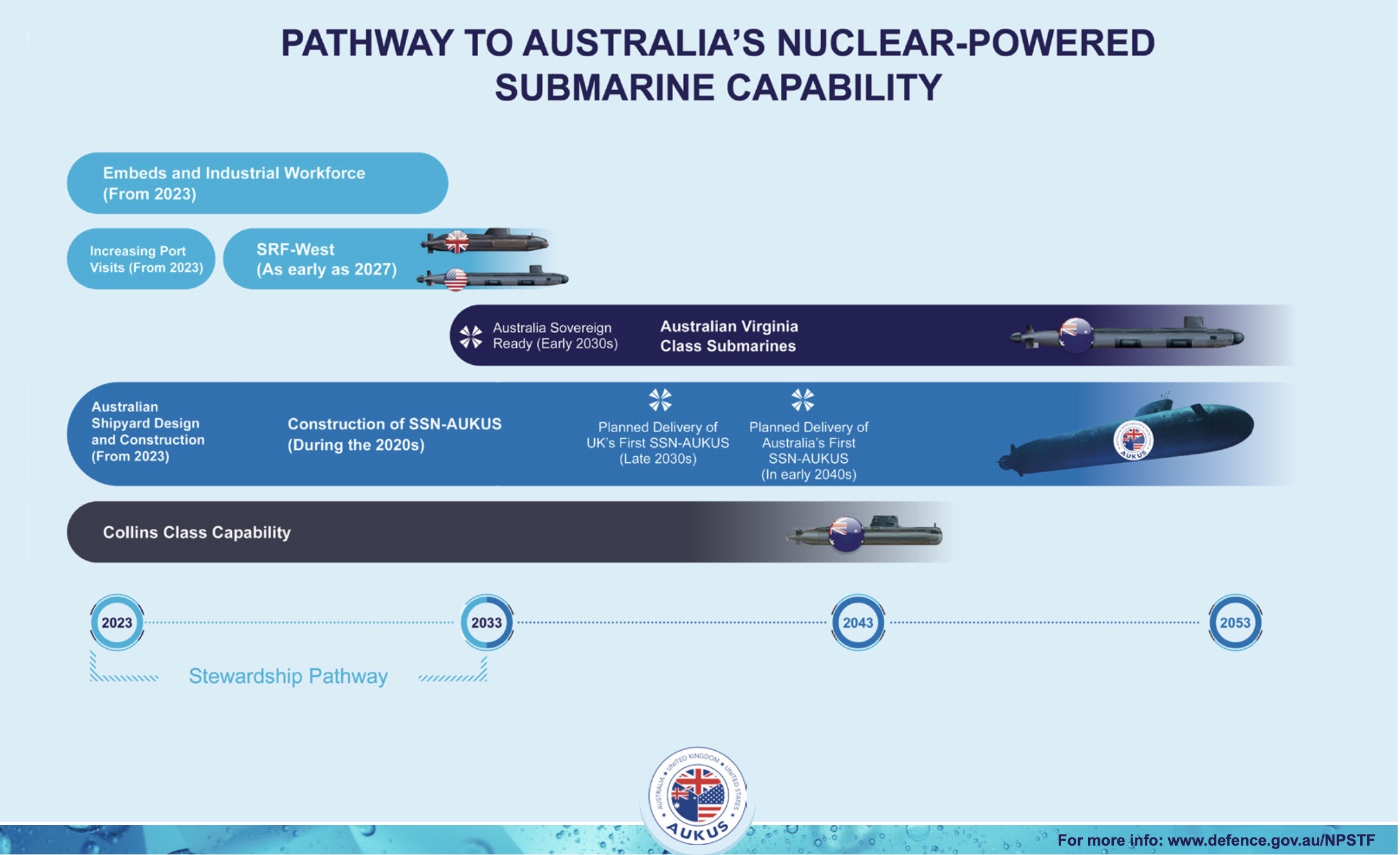$368 billion, 20,000 jobs over 20 years: How AUKUS could ‘fundamentally transform’ Australia
AUKUS #AUKUS


Australian Defense Minister Richard Marles, center, speaks to the press at Parliament House on March 14. (Lauren Larking, Australian Defense Force)
SYDNEY — With the official AUKUS ceremony out of the way, Tuesday marked the start of the real work for Australia as it begins to grapple with the vast panoply of details that will make or break plans to buy and operate Virginia- and AUKUS-class submarines over the next half-century.
It is, in the words of one defense industry expert, “Probably the biggest engineering initiative” for Australia since the famed Snowy Mountain hydroelectric scheme, which began in 1949 and ended in the mid-1970s. For context, effort employed more than 100,000 people over its course and was designated one of the civil engineering wonders of the world by the American Society of Civil Engineers.
“This is that kind of national endeavor and national scale,” said Sarah Pavillard, an almost 20-year veteran of the Royal Australian Navy who is now CEO of the medium-sized defense consulting firm, Adroita.
Pavillard spoke with Breaking Defense a few hours after Prime Minister Anthony Albanese stood with his back to the Pacific Ocean and a Virginia-class nuclear-powered attack sub and revealed the AUKUS program would cost an estimated $368 billion AUD and generate up to 20,000 jobs, many of them in industries with a very small presence in Australia.
RELATED: ‘SSN AUKUS’: How the US and UK plan to get nuclear-powered subs to Australia
Albanese’s comments, made alongside US President Joe Biden and UK Prime Minister Rishi Sunak, were followed by a rare press conference by Defense Minister Richard Marles and Pat Conroy, the minister for defense procurement. Marles and Conroy rarely speak to the press about defense, except for short interviews. In this case, the minister tried to put the importance of the AUKUS agreement into persective.
“The announcement that we have seen this morning from the Point Loma Naval Base in San Diego represents one of the biggest decisions that an Australian government has ever made. This is the biggest defense procurement, in fact, it’s the biggest procurement in Australia’s history,” Marles said.
“Australia will now be just the seventh country to operate a nuclear-powered submarine. And this represents the biggest leap in our military capability since the end of the Second World War; arguably it’s the biggest leap in our military capability in our history.”
The main defense industry association in Australia certainly didn’t downplay the economic impact, claiming that AUKUS “will fundamentally transform Australia as a nation and this cannot be understated.”
The Australian Industry & Defense Network (AIDN) said the Australian Defense Force, industry and the Albanese Labor Party government now has to make good on the promise of the agreement and make sure “as much activity as possible is undertaken by Australian companies. This is a unique opportunity for Australia, the US and the UK to develop a common supply chain to ensure that the full benefits of AUKUS can be realised.”
A virtual torrent of cash will begin to flow this year as Australia begins work to expand its Western Australian sub base, HMAS Stirling, where the US plans to increase nuclear attack sub port visits beginning in 2023. Australian sailors will join US crews for training and development during these visits, with the UK increasing its port visits in three years. All that will require more space, more security, and more communications capabilities at Stirling.
The head of Australia’s submarine task force, which led work on the AUKUS sub deal, appeared with Marles and Conroy and detailed how much cooperation there has been between his country, the UK and the US over the past 18 months.
“They have shown us facilities that no Australian has ever been exposed to before. They have flown to our country — they have had a very deep and immersive look at Western Australia and South Australian facilities. We’ve gone to all their facilities in Barrow, Derby Rolls-Royce, in the shipyards and in the UK as well and we’ve sent other people to Guam and Pearl Harbor,” Vice Adm. Jonathan Mead told reporters.

AUKUS Fact Sheet by Australian MoD
More Money, More Problems?
Of course, any mammoth effort usually faces mammoth challenges, and with AUKUS those challenges are both budgetary and technical.
“Will all three nations support the buildout of these submarines with the necessary budgetary commitments? Will it receive bipartisan support over the long-haul and stay consistent? How quickly can the production capabilities ramp up? Will industry and government find, train, and retain an adequate workforce? Will the AUKUS partnership find a way to change some of the rules, regulations, and laws governing the sharing of sensitive technology? And, perhaps most important,” asks Charles Edel, Australian expert at Washington DC’s Center for Strategic and International Studies, “will the initiative that was launched today embolden other nations to invest in their own defense?”
Added Mark Watson of the Australian Strategic Policy Institute, “There is a legitimate question around how the Australian Government will fund the acquisition and maintenance ramp up. Australia currently has a A$50 bn deficit baked into its budget, so adding an additional 1- 1/12 % of GDP will require hard decisions around government revenues and/ or expenditures.”
Watson also noted the mix of British, American and Australian-made technology increases the chance of delays caused by integration efforts.
Perhaps the most complex and politically thorny problem the AUKUS program will face in the long run is how to deal with the nuclear waste generated by the Virginia- and AUKUS-class boats. While the reactors are sealed and the boats do not need to be refueled through their 30-year life, they do generate contaminated liquids and parts. Most importantly, the reactors need to be disposed of at the end of their life.
Marles told reporters today that Australia would handle and store that waste, something with which the country has very little experience. While Marles did not spell it out, the most likely places to store that waste are in the country’s vast and sparely populated north and west, but there’s a history of nuclear testing that may complicate the education and negotiations that will be required.
Britain executed nine nuclear bomb tests at two Western Australian sites, Emu Field and Maralinga, with Australia’s permission. These were essentially ground-level tests. Those were followed by other tests, described as “minor,” some of which involved plutonium-239. Huge swaths of land were contaminated.
Most of it has, apparently, been mitigated and the traditional owners of the land, the Maralinga Tjarutja people, were compensated by the Australian government — but that doesn’t mean nuclear exposure will be welcomed back.
“I would expect extraordinary resistance from Australia’s indigenous communities, particularly in the regions around where atomic testing may have occurred historically,” a source familiar with the issue said. Australia has a long time to get this right — the first major nuclear waste probably won’t need storage until the 2050s, Marles said at his press conference.
But it may well be politically challenging, and it’s an issue already being raised. The capital city of South Australia, Adelaide, is expected to benefit handsomely from the jobs that will be generated by the AUKUS sub work at its shipyards, and yet the first question to Marles was blunt, with a reporter asking if “a high-level nuclear waste dump the price that South Australia will have to pay for the jobs” the AUKUS deal promises to bring in.
Marles, for his part, kicked the can down the road, saying “Well, as I indicated there will be a process that we will determine within the next 12 months for how the site will be identified. You’ve made a leap there, which we’re not going to make for some time. It will be a while before a site is ultimately identified. But we will, within the next 12 months, establish a process for how we walk down that path.”
Back in Washington, Albanese and Biden met for a bilateral chat, and the president confirmed he will visit Australia in May for the Quad meeting they are hosting.
And Biden, keenly aware that China has opposed AUKUS and criticized Australia for its actions, said he does not see the AUKUS plan “as a challenge to anybody. I view it as a means by which we’re bringing stability into the South China Sea, the Indian Ocean. And I think it’s going to be greeted — when they realize our purpose — by everyone as maintaining stability and security,” he said.
Justin Katz in Washington contributed to this report.
Recommended